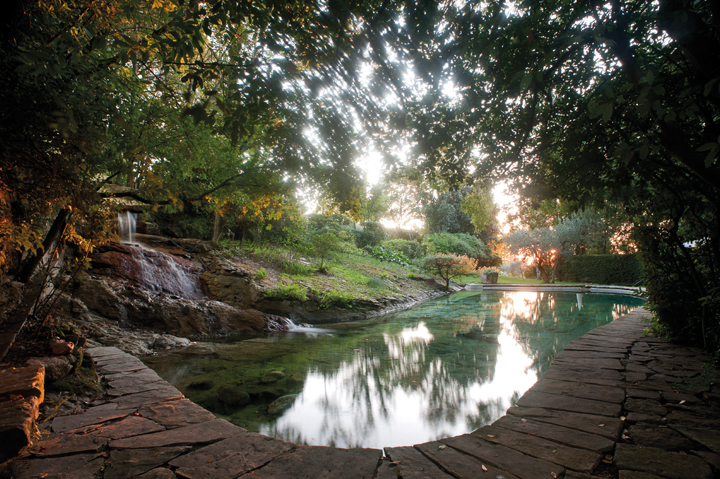
Over the Ferragosto week, outdoor physical activities might not be the first thing on a holidaymaker’s mind. In fact, many Tuscans look forward to lying on a beach or pool with occasional dips to cool off. But some contemplate a walk or a gentle hike in a tree-shaded forest, perhaps along a stream with cool, clear water. After weeks of lockdown and overindulging in TV and perhaps snack food, a little exercise immersed in nature might be just the perfect thing for August.
An easy hike from the village of Fiesole takes one through forests and past quarries where pietra serena, the grey sandstone which was used for many of the buildings in Renaissance Florence, was sourced. Monte Ceceri Park, the prominent hilltop one sees looking up from Florence to Fiesole, offers several marked itineraries through shady forests and views over Florence and the Tuscan countryside towards Settignano. Fiesole, four miles (7 km.) from Florence, can be easily reached by car or ATAF bus #7. It is advised to stop off at the tourist office, just next to the Teatro Romano archeological site to pick up a map with three possible itineraries through the park. The Via Panoramica begins from the main piazza, Piazza Mino, staying right from the bus stop.
The walk, marked with red and white paint on houses, begins from the main piazza, Piazza Mino, staying right from the bus stop down Via Giuseppe Verdi. Walk along the road with panoramic views down on Florence. At the corner of Via Verdi and Monte Ceceri, note the plaque on the house denoting the residence of architect Frank Lloyd Wright in 1910. Continue right onto Via Monte Ceceri and take the Via degli Scalpellini (the stonecutters’ road), which leads downhill past a sign for the Parco di Montececeri. The road soon bears to the right and becomes a track, which leads into a wood. At the first fork, hikers can go left up to Piazzale Leonardo da Vinci to a monument commemorating the spot where Da Vinci conducted his first flight experiments. Taking the right fork, one arrives at the Cave Braschi, a quarry dug into the hillside. Continue back on the trail to the opposite entrance to the park with a parking lot and onto Via Corsica. From there walk through the town and into the main street Via Giacomo Matteotti. This hike does not have water along the route, but thirsty hikers can stop at one of the cafes on Piazza Mino for a refreshing drink and a snack.
The Pistoia Mountains, popular with regional vacations this year, also offers day trips. The Forest Botanical Garden of Abetone (open Wednesday – Sunday from 9 am to 12:30 pm and between 3:30 and 6 pm, admission €4) was created to provide a study center for Tuscany’s three universities: Florence, Pisa and Siena. Most of the plants are identified by a nametag; guided tours to better appreciate the flora are available daily at 9:30 and 11 am and again at 4 pm). Reaching an elevation of 3,280 ft. (nearly 1,000 meters, the Botanical Garden’s woodlands cover more than 75% of the total area. The rest is landscaped and includes a rock garden full of spontaneous wildflowers. The Forest Botanical Garden is also the starting point for a hike beneath towering fir and beech trees and wild blueberry bushes to Lago Nero, a glacial lake, by following the CAI trail #104 for an hour-and-a-half to two hours up to an altitude of 5,675 ft. (1730 meters). Along this moderately difficult hike, visitors may find the Cassetta dei Pastori mountain lodge open for a pleasant stop-off. For more information on the area, call the Tourist Board at 0573/60231.
Even on the hottest of days, the Cantagallo Riserva Naturale Acquerino park promises relief from the summer heat. The reserve, 30 minutes north of Pistoia on SP24, lies in the sparsely populated area between Cantagallo and the village of Sambuca. The Carigiola stream flows down from the Apennines with cool, fresh water inviting one to wade and perhaps even swim. A short walk leads to a waterfall with a clear pool underneath. Hiking along the trail shaded with chestnut and beech trees, visitors might catch sight of deer, fox or even a porcupine. This is a great spot to take the family, a picnic and the dog for a refreshing day in the mountains.
Another trail following a stream with several waterfalls and the Rovigo River can be found in the Mugello in the foothills of the Apennines. The Cascate dei Diacci loop trail begins at the large parking lot of Prato all’Albero, which is north of Borgo San Lorenzo on SR302, then left on SP477. This moderate 4-mile (6.3 km.) walk takes about two hours to complete, taking the hiker first on CAI trail #743 through a well-shaded forest of beech and oaks, past a mountain hut, Capanna Marcone, on to Mulino dei Diacci, an old mill, and back again to the Prato all’Albero. Hikers should be prepared to ford the small stream in several spots.
For more challenge, a three-hour loop in Chianti, it’s recommended to do in the morning with lower temperatures. The Lamole-Monte San Michele loop begins in the hamlet of Lamole, 15 minutes from Greve in Chianti, taking SR222 south and then following the signs at a left turn for Lamole. Walking through quintessential Chianti countryside on high ridges, through vineyards and woods, past old stone houses and seasonal streams, the visitor enjoys vistas in every direction. The halfway point, Monte San Michele, at 892 meters, is the highest point in Chianti. Here on the grassy slope in front of the hotel of the same name, with restaurant and snack bar, one finds a perfect picnic spot. Returning to Lamole, the trail mostly descents and provides more spectacular views of Chianti. The familiar red and white trail markers, erected by CAI, the Italian Alpine Club, make the trail easy to follow and, depending on how long the lunch break, the hike should take a total of three hours or a bit more. Back in Lamole, the restaurant Ristoro di Lamole serves delicious food. If the weather is fine, a drink on the terrace is recommended. Linger a while and the hiker will be treated to a fabulous sunset.
Tuscany boasts beautiful nature, forests, parks and protected areas within a few kilometers of metropolitan Florence. Hopefully this summer Tuscans and visitors alike can enjoy these areas. Of course, with the heat be sure to pace the hiking and carry drinking water. (rita kungel)








